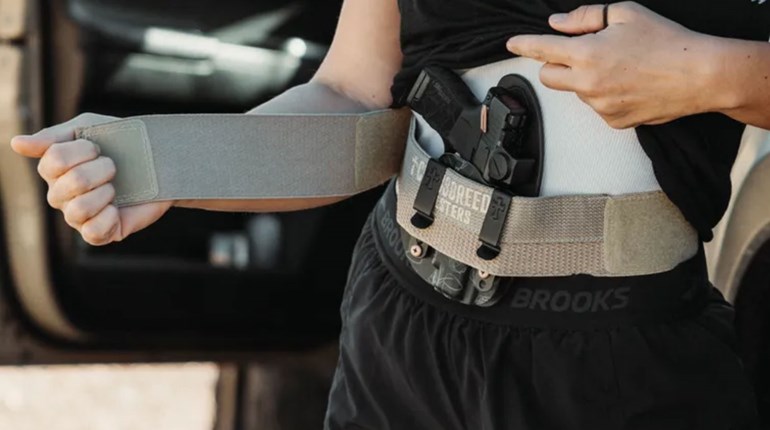
Getting used to carrying a concealed handgun requires some notable lifestyle adjustments. It changes your daily routine, accessory set and sometimes your wardrobe. And no matter which handgun you choose, even one of the smaller pocket or micro pistols, it adds weight. Whether it rides on your hip in a holster or tucked into a pocket of an already overloaded handbag, that weight can feel heavy to haul around by the end of the day. It’s not uncommon for those who are new to concealed carry to wonder whether it’s worth the added weight to carry a reload for their gun.

Even small handguns like the Smith & Wesson J-Frame Air Weight and sub compact Taurus GX4 9 mm pistol can seem like a burden to lug around all day if you’re new to carrying a handgun for personal protection.
A reload (not to be confused with “reloaded” ammunition assembled from used cartridge cases) is enough additional ammunition to refill a handgun if it's fired until empty in the course of a defensive situation. Speed loaders or quick strips (for revolvers) and additional magazines (for semi-automatic pistols) are used to reload the handgun quickly and bring it back into action. Let’s take a look at these common reloading devices and the reasons it’s a good idea to use them.

Speed loaders (left) and speed strips are convenient options for carrying additional ammunition for your revolver.
Although it is possible to reload a revolver with loose ammunition from a pocket or box, it's too slow of a process in a defensive situation. A speed loader is a polymer or aluminum dispenser which holds revolver cartridges by their rims with the bullets facing out. The holes in the loader align with the chambers of the revolver's cylinder. Pressing the loader into the empty cylinder reloads all of the chambers at once. The speed loader's handle, or knob, is then pressed or twisted to release the cartridges. The machined aluminum 5 Star Firearms loader shown here is the twist-knob type. The loader can then be dropped to the ground or pocketed before closing the revolver's cylinder. It's not quite as fast as replacing a semi-auto's magazine but with some practice it’s pretty close.

Speed loaders can reload all of a revolver’s chambers at once.
Another option for carrying revolver ammunition is a rubber strip which holds the cartridges by their rims, bullets facing out, all in a row. Although the brand names vary, they are often called speed strips after the Bianchi Speed Strip, much like facial tissue is referred to Kleenex. I'm a fan of Tuff Product's Quick Strips, which are available in a wide variety of calibers, round counts and colors.

Speed strips allow two rounds to be loaded at a time.
These strips allow two cartridges to be pressed into the cylinder at the same time. The soft rubber strip is then twisted away from the cylinder to release the cartridges. This is a slower process than using a speed loader. However, loaded speed strips have a flat profile that allows them to fit into pockets and places that are not a good fit for speed loaders.
One of the reasons semi-auto pistols are so popular for self defense is that they come with a quick-reload system built right in. Removable box magazines allow additional ammunition to be conveniently carried and ready to use. They slip right into a pistol's grip when the empty magazine is dropped out by pressing the magazine release.
But how much ammunition do you need to have on hand in order to effectively defend yourself? If you look through the extensive data collected by law enforcement agencies, the information gathered by top professional trainers and the accounts of civilian self defenders, the answer is: It depends on the situation.
Statistically speaking, the majority of armed citizens will avoid having to use a gun to protect their lives or someone else's at any point in time. In those situations where a self defender does retrieve or drawn a firearm, it's more likely that the conflict will be resolved without any shots being fired by the defender. In those cases in which civilians do fire, they tend to fire a few shots at relatively close distances in a short period of time.

Magazines are simple machines with moving parts. Most modern pistol magazines are reliable most of the time but they do malfunction occasionally.
These averages lend credence to the commonly quoted “Rule of Three,” which states that if a civilian gets into a gun fight then it’s likely to involve around three shots fired from approximately three steps (or three yards) in about three seconds. But this is a guideline meant to serve as a starting point for those who are learning the principles of self-defense planning. Although averages are useful as educational models, they rarely represent what can actually happen in the real world.
Simply stated, emergency preparedness is not about getting ready for things to go as planned. Spare tires, extra flashlight batteries and first aid kits are there in case things go sideways. Defensive handguns fall into this same emergency preparedness equipment set, and ammunition is the “fuel” that keeps them going in a personal protection situation.

If you carry a small-caliber pistol, like the Ruger LCP II Lite Rack chambered in .22 LR, then carrying a reload or two is a must.
If you carry a relatively low-capacity firearm, such as a small revolver or a single-stack pocket pistol, then the arguments in favor of carrying at least one reload are fairly self-evident. A speed loader for a 5-shot revolver doubles the rounds on hand to 10. For small-caliber pistols it’s more likely that follow-up shots will be needed.
But right now we are seeing a surge in the popularity of micro and compact size 9 mm pistols that hold a good deal of ammunition in their magazines. These easy to carry pistols can comfortably hold between 10+1 to 13+1-rounds of ammunition. Is there really a need to carry additional magazines with that many shots on board?

Pistol magazines are simple machines with springs and moving parts which means they can malfunction. The feed lips can get bent or damaged, the cartridges can jam inside the magazine body or the spring may be too weak. In all of these cases, that particular magazine is going to fail to feed properly. Magazines can also be dropped at inopportune times. Either way, lost or malfunctioning, if you only have one magazine then the pistol becomes a single-shot that can only fire the round in the chamber.
Clint Smith, the founder of Thunder Ranch, summed up the need for extra magazines neatly when he said, "2 is 1 and 1 is none." In other words, if you don't have a backup when your primary magazine fails (or any other tool for that matter) then you will be left with nothing to work with. Remember, a gun that's out of ammunition is not much more that a sophisticated paper weight. Is carrying a reload worth the weight? Yes, it is.















































